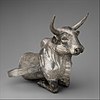Anatolian peoples

Anatolians were Indo-European peoples of the Near East identified by their use of the Anatolian languages.
History[edit]
Together with the Proto-Tocharians, who migrated eastward, the Anatolian peoples constituted the first known waves of Indo-European emigrants out of the Eurasian steppe.[1] It is likely that they reached the Near East from the north, via the Balkans or the Caucasus, in the 3rd millennium BC.[2][3][4] This movement has yet to be documented archaeologically.[4][5] Although they had wagons, they probably emigrated before Indo-Europeans had learned to use chariots for war.[1] Comparasion of Hittite agricultural terms with those of other Indo-European subgroups indicate that the Anatolian peoples seceded from the other Indo-Europeans before the establishment of a common agricultural nomenclature, which suggests that the they entered the Near East as a cohesive people through a common route.[4] Once the they entered the region, the cultures of the local populations, in particular the Hattians, significantly influenced them lingustically, politically and religiously.[4] Christopher I. Beckwith suggests that the Anatolian peoples initially gained a foothold in Anatolia after being hired by the Hattians to fight other invading Indo-European groups.[5]
The earliest linguistic and historical attestation of the Anatolian peoples are names mentioned in Assyrian mercantile texts from 19th Century BC Kanesh.[5][6] The Hittites established an extensive empire in the Middle East in the 2nd millennium BC and are by far the best known of the Anatolian peoples. Other groups were the Luwians, who migrated to south-west Anatolia in the early Bronze Age, and the less known Palaic peoples, who inhabited the region of Pala in northern Anatolia.[7]
Following the Bronze Age collapse, a number of Neo-Hittite petty kingdoms surivived until about the 8th century BC. Later in the Iron Age, Anatolian languages were spoken by the Lycians, Lydians, Carians, Pisidians and others. These languages were mostly extinct in the Hellenistic period, by the 3rd century BC, although late survival of some remnants is possible, the Isaurian language may have survived into the Late Antiquity, with funerary inscriptions recorded for as late as the 5th century AD.
List[edit]
| Part of a series on |
| Indo-European topics |
|---|
 |
|
|
Origins |
|
Archaeology Pontic Steppe Caucasus East Asia Eastern Europe Northern Europe Pontic Steppe Northern/Eastern Steppe Europe
South Asia Steppe Europe Caucasus India |
|
Peoples and societies Indo-Aryans Iranians East Asia Europe East Asia Europe Indo-Aryan Iranian |
|
|
See also[edit]
Some use of "" in your query was not closed by a matching "".Some use of "" in your query was not closed by a matching "".
- List of ancient peoples of Anatolia
- Mitanni
- Kassites
- Purushanda
- Hyksos
- Sea peoples
- Qiang
- Philistines
- Wusun
- Yuezhi
- Ordos culture
- Maryannu
- Indo-Aryan superstrate in Mitanni
- Kikkuli
References[edit]
- ↑ 1.0 1.1 Beckwith 2009, p. 32
- ↑ Mallory 1997, pp. 12–16
- ↑ Hock & Joseph 1996, pp. 520–521
- ↑ 4.0 4.1 4.2 4.3 "Anatolian languages". Encyclopædia Britannica Online. Retrieved July 2, 2018.
- ↑ 5.0 5.1 5.2 Beckwith 2009, p. 37-39
- ↑ Fortson, IV 2011, p. 48
- ↑ "Anatolia: The rise and fall of the Hittites". Encyclopædia Britannica Online. Retrieved July 3, 2018.
Sources[edit]
- Beckwith, Christopher I. (2009). Empires of the Silk Road: A History of Central Eurasia from the Bronze Age to the Present. Princeton University Press. ISBN 1-4008-2994-1. Retrieved 30 October 2012. Search this book on

- Fortson, IV, Benjamin W. (2011). Indo-European Language and Culture: An Introduction. John Wiley & Sons. ISBN 1-4443-5968-1. Retrieved 30 October 2012. Search this book on

- Hock, Hans Heinrich; Joseph, Brian Daniel (1996). Language History, Language Change, and Language Relationship: An Introduction to Historical and Comparative Linguistics. Walter de Gruyter. ISBN 3-1101-4784-X. Retrieved 30 October 2012. Search this book on

- Mallory, J. P. (1997). Encyclopedia of Indo-European Culture. Douglas Q. Adams. ISBN 1884964982. Retrieved 23 March 2013. Search this book on

- Melchert, H. Craig (2012). "The Position of Anatolian" (PDF). Archived from the original (PDF) on 2010-07-09.
- Sharon R. Steadman; Gregory McMahon (15 September 2011). The Oxford Handbook of Ancient Anatolia: (10,000–323 BCE). Oxford University Press. ISBN 978-0-19-537614-2. Retrieved 23 March 2013. Search this book on

| This article about ethnicity or ethnology is a stub. You can help EverybodyWiki by expanding it. |
This article "Anatolian peoples" is from Wikipedia. The list of its authors can be seen in its historical and/or the page Edithistory:Anatolian peoples. Articles copied from Draft Namespace on Wikipedia could be seen on the Draft Namespace of Wikipedia and not main one.

|
This page exists already on Wikipedia. |

